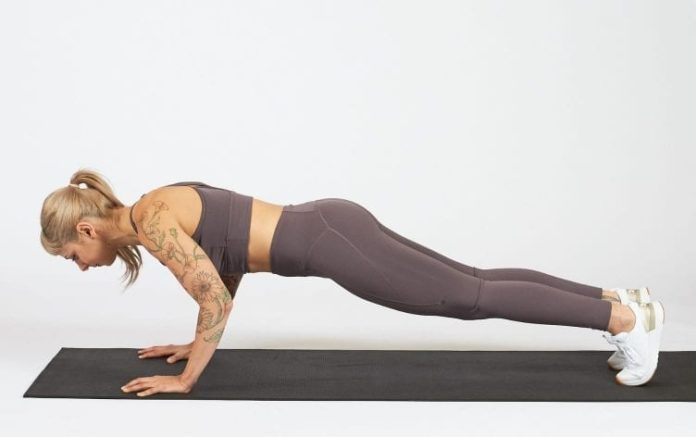
Pushups are one of the most fundamental exercises. And yet, very few people can do a truly perfect pushup — most just slog through the required reps as best they can.
“Everyone understands the general concept of a pushup,” says Katie Collard, certified strength and conditioning specialist and head coach at Cut Seven. “What they don’t understand is that a pushup uses your entire anterior chain. To do one correctly, you must activate every muscle in the front of your body.”
Once you shift your mindset and start thinking about pushups as a total-body exercise rather than a chest and arm exercise, they become easier to improve. “Your body is a complete system that works as a whole,” Collard points out. “Stop thinking of pushups as a single muscle group exercise, and you will see progress.”
1
SKIP KNEE PUSHUPS
Most people aren’t able to start with a full pushup straight away. At least, not with good form. (If you are, count yourself lucky.)
The most common modification for working up to a full pushup is going down to your knees. However, experts don’t actually recommend these if your goal is to get to the full move. “The problem with knee pushups is that they’re far too easy to have much carryover to a full pushup,” explains Greg Pignataro, certified strength and conditioning coach at Grindset Fitness.
“To fix this, I recommend people who aren’t confident with pushups set up stackable steps or barbell plates and straddle them with their arms,” Pignataro says. Focus all your energy on keeping your glutes squeezed, abs flexed and elbows tracking backward and lower down until you gently touch the step, then push yourself back up.
“Even if you can only maintain this for a small descent that is 2–3 inches below the top of the pushup, that’s totally fine. Building these habits will yield fast, impressive progress,” he adds. Once you can do 15–20 of these “high” pushups, increase the difficulty by making the platform lower. “By utilizing this strategy, even someone who hates pushups can safely and properly perform chest-to-floor push-ups before they know it.”
2
TRY ECCENTRIC PUSHUPS
Another modification option: “The exercise I see the best results with is an eccentric — or ‘slow’ — pushup,” Collard notes. (FYI, “eccentric” describes the lowering portion of the pushup movement.)
“With an eccentric pushup, the idea is to lower as slowly as you possibly can to the ground, drop, then reset at the top of the pushup position,” Collard explains. “This does several things: It mimics that true pushup form, trains the right muscles (especially your abdominals) and helps you practice full range of motion. Basically, it allows your body to learn how to do a pushup with proper technique.”
3
KEEP YOUR “ELBOW PITS” FACING FORWARD
Getting your hands in the right position for a pushup matters, but getting your elbows tracking in the right direction is important, too. “Rotate your hands a tiny bit externally (so your fingers turn slightly away from you) so that the ‘pit’ of each of your elbows (also known as the cubital fossa) is facing straight ahead,” Pignataro instructs.
“In this position, when you bend your elbows to perform the pushup, they will track backward instead of flaring outward. The benefits of this are numerous. Your shoulders stay in a much safer position, and you’ll increase triceps activation while still using the pecs and delts as the primary movers.”
4
SQUEEZE YOUR INNER THIGHS FOR BETTER CORE ENGAGEMENT
You’ve probably heard the tip to keep your core engaged throughout a pushup a million times. But if you’re not sure what that feels like, it’s easier said than done. Surprisingly, you can recruit your lower body to help keep your core turned on.
When your adductors (inner thigh muscles) are activated, they help stabilize your pelvis, which allows the core to have a strong foundation while doing pushups, explains Jennifer Novak, MS, a certified strength and conditioning coach and owner of Peak Symmetry. When your hips are externally rotated — in other words, when your feet are turned out slightly — your adductors can more easily activate.
So when you set up for your pushup, step your feet apart slightly, turn your toes out a little bit and squeeze your inner thighs together (without letting them touch). For some people, this is easier to achieve by squeezing a small ball between your thighs. “This hip rotation/foot position tip can be used to help keep the pelvis level so that important core muscles can engage, keeping the hips from dropping below the plank position,” Novak adds.
5
USE THIS PLYOMETRIC TRICK
If you still need help with your pushup, you can take advantage of something called post-activation potentiation, Novak says. It sounds complicated, but it’s not: “It’s using a plyometric exercise prior to attempting the pushup to increase firing rate of the muscle,” she explains.
Here’s how to do it: “Stand an arm’s length away from a sturdy wall, and with the body tall and stable, fall toward the wall until the hands touch the wall, then push away with the arms to the former upright position.” After doing this several times, try doing a regular pushup on the floor and see if it feels any easier — it should!







